Featured instruments from Vintage American Guitar.
-
Out of stock
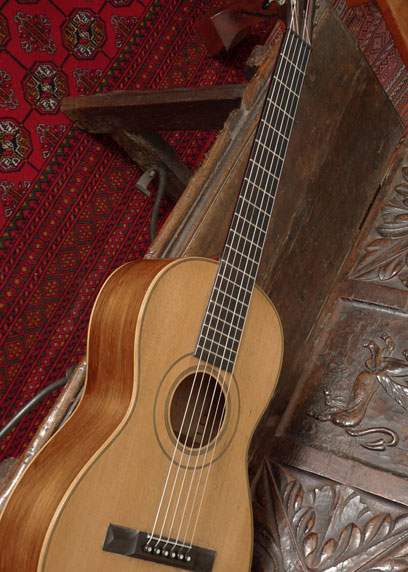 Circa 1860 guitar, style 3 built by well known luthier James Ashborn of Wolcottville, CT, for William Hall & Son music store. Brazilian rosewood back and sides; Adirondack top; maple binding. Rare Brazilian rosewood veneered neck. 100% original, including all original finish, and down to original nut, original bridge (and saddle) that has never been off the guitar. From an article in Vintage Guitar magazine: "Ashborn's design for the guitar was quite innovative for the early 19th century. Instead of making guitars fashioned after the typical parlor-style guitars, he made them in the Spanish style, by taking interior bracing cues from the Spanish while retaining the body of the English guitars. This included a fan brace pattern rather than the more common ladder pattern Ashborn guitars have a very complex dovetail V joint for attaching the head to the neck. The headstock was cut in roughly five steps, using some kind of tracing router, as suggested by the chatter marks on the inside ears of the pegbox. In addition to the complex head design, Ashborn made his own tuning machines in-house. They're made of brass, very much like contemporary machines, with worm gears, cog gears, and rollers. … Ashborn's shop was extremely advanced for its time, having a great deal of know-how and technology. Ashborn understood the need to have the technology as well as the skill, but more importantly he discovered a new way of making high-quality instruments that were affordable. He was able to create a factory environment where workers did what they were good at and, with practice, became very fast and consistent. With a new level of consistency in mass production, he created the path followed by other companies such as Martin, Gibson, and Taylor. Using designs ahead of his time, he was able to bring the sound and change to people who otherwise never would have been able to acquire an instrument of this quality."
Circa 1860 guitar, style 3 built by well known luthier James Ashborn of Wolcottville, CT, for William Hall & Son music store. Brazilian rosewood back and sides; Adirondack top; maple binding. Rare Brazilian rosewood veneered neck. 100% original, including all original finish, and down to original nut, original bridge (and saddle) that has never been off the guitar. From an article in Vintage Guitar magazine: "Ashborn's design for the guitar was quite innovative for the early 19th century. Instead of making guitars fashioned after the typical parlor-style guitars, he made them in the Spanish style, by taking interior bracing cues from the Spanish while retaining the body of the English guitars. This included a fan brace pattern rather than the more common ladder pattern Ashborn guitars have a very complex dovetail V joint for attaching the head to the neck. The headstock was cut in roughly five steps, using some kind of tracing router, as suggested by the chatter marks on the inside ears of the pegbox. In addition to the complex head design, Ashborn made his own tuning machines in-house. They're made of brass, very much like contemporary machines, with worm gears, cog gears, and rollers. … Ashborn's shop was extremely advanced for its time, having a great deal of know-how and technology. Ashborn understood the need to have the technology as well as the skill, but more importantly he discovered a new way of making high-quality instruments that were affordable. He was able to create a factory environment where workers did what they were good at and, with practice, became very fast and consistent. With a new level of consistency in mass production, he created the path followed by other companies such as Martin, Gibson, and Taylor. Using designs ahead of his time, he was able to bring the sound and change to people who otherwise never would have been able to acquire an instrument of this quality." -
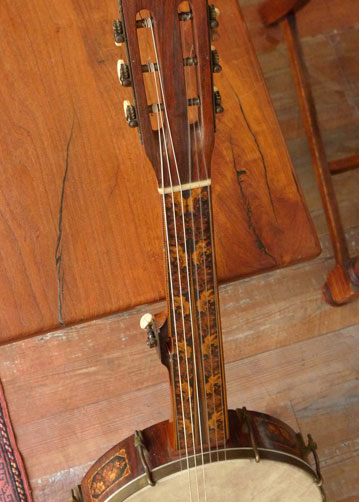 Read the full description below. If you're interested in this guitar, please call 512.922.8596 or contact us here.
Read the full description below. If you're interested in this guitar, please call 512.922.8596 or contact us here. -
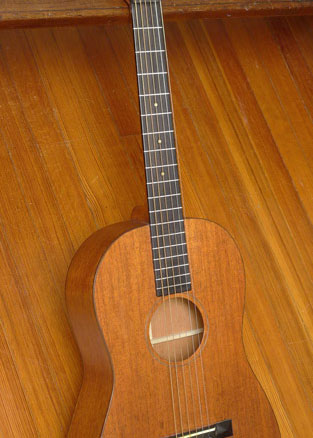 This is a very well made, custom Hawaiian guitar. Made by George Bailey, and signed and dated underside of top, 2009. The body style is similar to an early Ditson. In other regards, its size, sound, and feel is quite similar to a 1930’s Martin 0-17H.
This is a very well made, custom Hawaiian guitar. Made by George Bailey, and signed and dated underside of top, 2009. The body style is similar to an early Ditson. In other regards, its size, sound, and feel is quite similar to a 1930’s Martin 0-17H.- Mahogany back, sides, and top
- Mahogany neck
- Ebony fretboard
- Ebony bridge
- Flush frets, with raised nut and saddle, for Hawaiian playing
- Ladder braced
- Lower Bout width: 13 ¼ inches
- Scale length: 25 inches
- 1 ¾ inch nut
- Crack-free
-
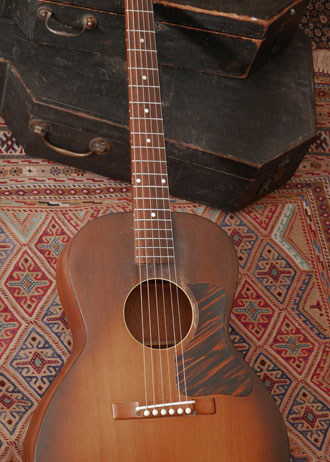 Read the full description below. If you're interested in this guitar, please call 512.922.8596 or contact us here.
Read the full description below. If you're interested in this guitar, please call 512.922.8596 or contact us here. -
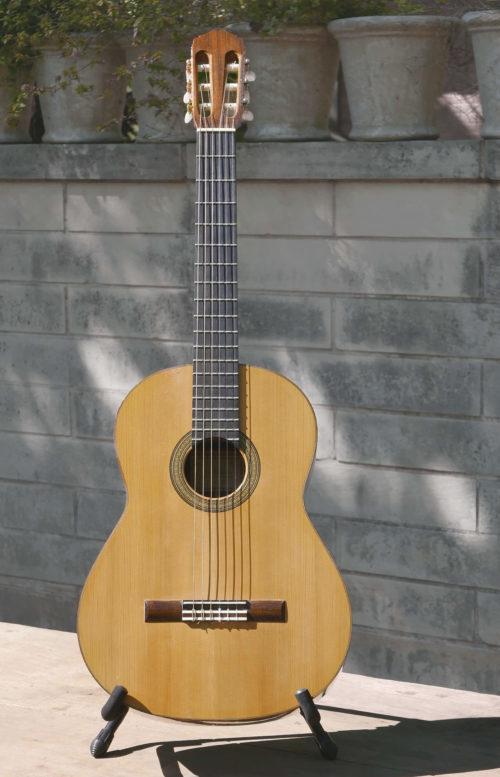 Tom Blackshear is a living legend in the classical and flamenco guitar worlds. He’s been building from his shop in Texas for decades, with an international client base and international prestige, and his older guitars especially are hard to find and in great demand (and rarely come to market. (There is currently one at Dream Guitars. This guitar was built in 1987, and was based on Jeffrey Elliott’s “1943 Hauser” plan. The tone is robust, and clear, with bright brazilian trebles, and the kind of nice string separation and clarity that an old German spruce top gives. The instrument:
Tom Blackshear is a living legend in the classical and flamenco guitar worlds. He’s been building from his shop in Texas for decades, with an international client base and international prestige, and his older guitars especially are hard to find and in great demand (and rarely come to market. (There is currently one at Dream Guitars. This guitar was built in 1987, and was based on Jeffrey Elliott’s “1943 Hauser” plan. The tone is robust, and clear, with bright brazilian trebles, and the kind of nice string separation and clarity that an old German spruce top gives. The instrument:- Tom Blackshear classical guitar, serial # 184, built in 1987; signed on label by the builder; also signed in pencil, on underside of top
- model: based on Jeffrey Elliott’s “1943 Hauser” plan
- Brazilian Rosewood back and sides
- German spruce top
- Brazilian Rosewood bridge
- Ebony fretboard
- Scale length: 660
-
Out of stock
 This guitar is a masterfully crafted interpretation of the fabled Roy Smeck, a slope-shouldered Gibson acoustic from the 1930s, which pairs a 12-fret neck with a standard, slope shouldered body, in Brazilian rosewood. From Charlottesville, Virginia-based Rockbridge -- one of the country’s most intriguing and masterful boutique luthiers. In a custom Cedar Creek case. Read the full description below. If you're interested in this guitar, please call 512.922.8596 or contact us here.
This guitar is a masterfully crafted interpretation of the fabled Roy Smeck, a slope-shouldered Gibson acoustic from the 1930s, which pairs a 12-fret neck with a standard, slope shouldered body, in Brazilian rosewood. From Charlottesville, Virginia-based Rockbridge -- one of the country’s most intriguing and masterful boutique luthiers. In a custom Cedar Creek case. Read the full description below. If you're interested in this guitar, please call 512.922.8596 or contact us here. -
Out of stock
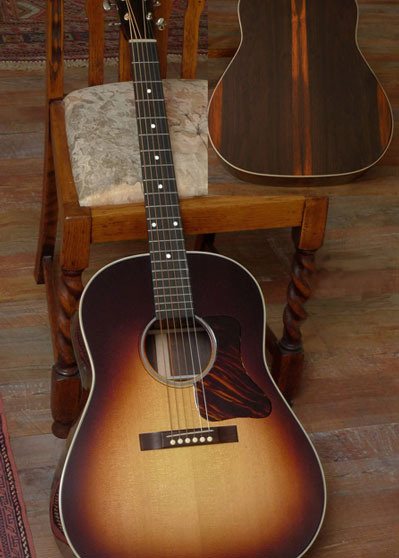 Another masterpiece from Charlottesville, Virginia-based Rockbridge Guitars. The slope shouldered dreadnought is faithful to the great Gibson J-35 of the late 1930’s, plus more: old-growth Brazilian Rosewood, with remarkable landscaping. Big big tone, volume, projection. Great sustain, ringing trebles, and yes most importantly string separation. Ebony fretboard. In a custom Cedar Creek case. Read the full description below. If you're interested in this guitar, please call 512.922.8596 or contact us here. ... no longer available ...
Another masterpiece from Charlottesville, Virginia-based Rockbridge Guitars. The slope shouldered dreadnought is faithful to the great Gibson J-35 of the late 1930’s, plus more: old-growth Brazilian Rosewood, with remarkable landscaping. Big big tone, volume, projection. Great sustain, ringing trebles, and yes most importantly string separation. Ebony fretboard. In a custom Cedar Creek case. Read the full description below. If you're interested in this guitar, please call 512.922.8596 or contact us here. ... no longer available ... -
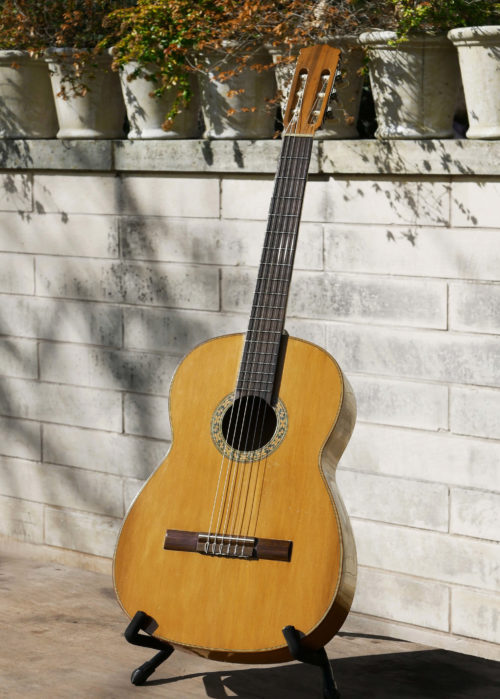 Another instrument from Enos Hernandez of Mexico, one of the best luthiers to ever live in work in Mexico, circa 1970’s. This one is a flamenco Blanca, with the classic cypress back and sides. Like the other Enos Hernandez we have, this one also has a cedar top. The instrument is super light weight, as a Flamenco Blanca should be, and it’s bright and percussive and raspy as a good Blanca should be. There is a scratch (not a crack) on back of guitar (see photo). There are dot position markers – original to the guitar, i.e. not added later – on top edge of fretboard (frets 3,5,7,9 – see photo). Scale length: 660mm Available January 2018 Price: $2950
Another instrument from Enos Hernandez of Mexico, one of the best luthiers to ever live in work in Mexico, circa 1970’s. This one is a flamenco Blanca, with the classic cypress back and sides. Like the other Enos Hernandez we have, this one also has a cedar top. The instrument is super light weight, as a Flamenco Blanca should be, and it’s bright and percussive and raspy as a good Blanca should be. There is a scratch (not a crack) on back of guitar (see photo). There are dot position markers – original to the guitar, i.e. not added later – on top edge of fretboard (frets 3,5,7,9 – see photo). Scale length: 660mm Available January 2018 Price: $2950 -
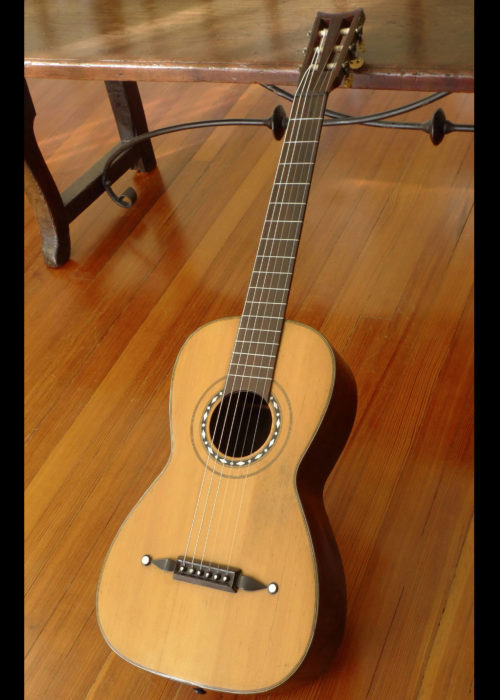 More rare than a Panormo guitar, this original, wonderfully preserved and sonorous guitar is from the London-based J. Guiot, circa 1846– and it’s a cousin if not a sibling of a Panormo, in style, appointments, and provenance. The headstock and neck volute of this instrument, as well as the bridge, exactly match that of two known Guiot guitars of the period (see links below). It’s possible that this guitar was made in the workshop of Panormo by Guiot while he worked there, and it is in fact Panormo in style, exactly– but likely it’s one of the very rare-on-the-market Guiot guitars made after Guiot established an independent workshop in the 1840’s. Either way, we guarantee it as a Guiot, and the value of Guiots– being very rare– are in line with Panormos. This guitar is in remarkable original condition, with none of the kinds of damage, major repairs, or structural issues found on nearly all surviving instruments of the period. And even more importantly, it plays wonderfully as well. We simply adjusted the nut a bit, and leveled the original frets, and it plays like it was recently made– but with a sound that only an 1840’s, London-made Spanish style guitar can produce. The intonation is great. Action is fine– not too high. Listen to the sound/video clip of this guitar being played, by clicking here. (Note: the video is labeled “Panormo” because the instrument was thought to be a Panormo when the recording was made. The guitar being played on the video is indeed this instrument). The guitar has a couple of repaired back cracks, and one well repaired top crack– amazingly little for a guitar this age. The features of this instrument: All original finish Spruce top Brazilian Rosewood back and sides Original Baker Tuners Original pin bridge, that has never been off the guitar Original frets Fan braced, 5 fan braces Scale length: 25 inches (63.5 cm) Lower bout: 11 3/8 inch (29.3 cm) Upper bout: 8 ¾ inches String spacing at bridge: 2 ½ inches Nut: 47 cm String spacing at nut: 1 ¾ inches Depth of sides (bottom): 4 inches (10cm) Depth of sides (top): 3 ½ Body length: 17 ¾ J. Guiot and A. Guiot were some of the luthiers who left France between 1830 and 1850, to work in London– and like Panormo, the Guiots made guitars in the Spanish style. Panormo had adopted a more Spanish style of guitar building in large part due to the urging of Fernando Sor– and that style that would soon overtake the French style, and eventually dominate in the new world as well (i.e. CF Martin’s adoption of the Spanish style of guitar making circa 1844 onward). The well known American composer and performer Madame Sydney Pratten was an ardent proponent of– and player of– the Guiot guitars in the mid-19th century. Reference: two Guiot instruments with the exact headstock and neck volute, and bridge (and also fret markers on 5, 7, and 9 position on the 1846 instrument): • Terz guitar, made by Guiot, Panormo model, London, made 1846– click here to view • J. Guiot, Panormo school guitar, made 1844 – click here to view. The instrument is in a modern hard shell case. Price: $6950.
More rare than a Panormo guitar, this original, wonderfully preserved and sonorous guitar is from the London-based J. Guiot, circa 1846– and it’s a cousin if not a sibling of a Panormo, in style, appointments, and provenance. The headstock and neck volute of this instrument, as well as the bridge, exactly match that of two known Guiot guitars of the period (see links below). It’s possible that this guitar was made in the workshop of Panormo by Guiot while he worked there, and it is in fact Panormo in style, exactly– but likely it’s one of the very rare-on-the-market Guiot guitars made after Guiot established an independent workshop in the 1840’s. Either way, we guarantee it as a Guiot, and the value of Guiots– being very rare– are in line with Panormos. This guitar is in remarkable original condition, with none of the kinds of damage, major repairs, or structural issues found on nearly all surviving instruments of the period. And even more importantly, it plays wonderfully as well. We simply adjusted the nut a bit, and leveled the original frets, and it plays like it was recently made– but with a sound that only an 1840’s, London-made Spanish style guitar can produce. The intonation is great. Action is fine– not too high. Listen to the sound/video clip of this guitar being played, by clicking here. (Note: the video is labeled “Panormo” because the instrument was thought to be a Panormo when the recording was made. The guitar being played on the video is indeed this instrument). The guitar has a couple of repaired back cracks, and one well repaired top crack– amazingly little for a guitar this age. The features of this instrument: All original finish Spruce top Brazilian Rosewood back and sides Original Baker Tuners Original pin bridge, that has never been off the guitar Original frets Fan braced, 5 fan braces Scale length: 25 inches (63.5 cm) Lower bout: 11 3/8 inch (29.3 cm) Upper bout: 8 ¾ inches String spacing at bridge: 2 ½ inches Nut: 47 cm String spacing at nut: 1 ¾ inches Depth of sides (bottom): 4 inches (10cm) Depth of sides (top): 3 ½ Body length: 17 ¾ J. Guiot and A. Guiot were some of the luthiers who left France between 1830 and 1850, to work in London– and like Panormo, the Guiots made guitars in the Spanish style. Panormo had adopted a more Spanish style of guitar building in large part due to the urging of Fernando Sor– and that style that would soon overtake the French style, and eventually dominate in the new world as well (i.e. CF Martin’s adoption of the Spanish style of guitar making circa 1844 onward). The well known American composer and performer Madame Sydney Pratten was an ardent proponent of– and player of– the Guiot guitars in the mid-19th century. Reference: two Guiot instruments with the exact headstock and neck volute, and bridge (and also fret markers on 5, 7, and 9 position on the 1846 instrument): • Terz guitar, made by Guiot, Panormo model, London, made 1846– click here to view • J. Guiot, Panormo school guitar, made 1844 – click here to view. The instrument is in a modern hard shell case. Price: $6950. -
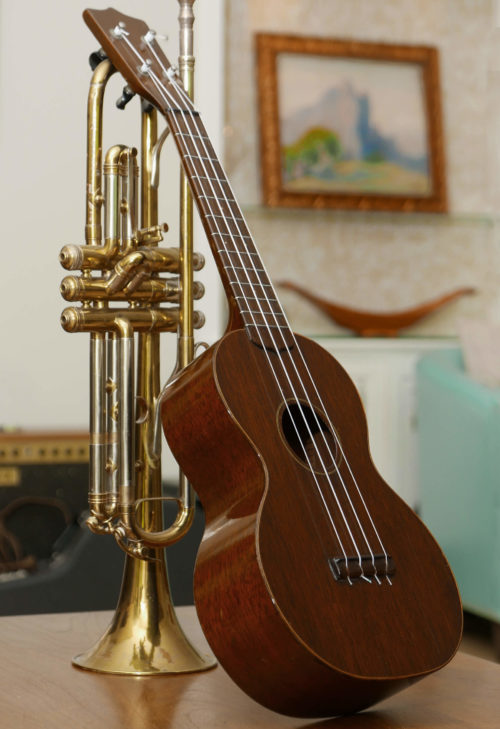 A beautiful example of one of the rarest prewar Martin ukuleles. This is a prewar Martin C-1. (All Concert Model ukuleles from Martin– with the exception of few special orders– were style 1). Officially called the Concert model ukulele, it’s larger than the many soprano size ukes. It’s very rare to find a prewar C-1 on the market– and much rarer still to find a pre-1933. This instrument was made between 1925 and 1933– because of the Martin stamp on the back of the headstock and the lack of the (post-1933) Martin decal on the front of the headstock. This is currently the only Martin C-1 from the late 1920’s on the market. And the tone and playability are perfect. Louder, and more bell like tone than a Martin Style 1 soprano uke. Martin concert ukuleles are the same body size as taropatch (1918-1932) but with four strings only. While the taropatch had been offered with four strings since its introduction, the new concert model was different in that it had a narrower neck and a standard soprano-size bridge. It was added to the standard catalog that year and by 1927 it was outselling all taropatch models combined. Concerts ukuleles are tuned the same as the sopranos but because of the larger body have a deeper and richer sound, and a slightly longer, easier to play scale length of 14 3/4". The Concert Ukulele from Martin–while rare to find a prewar example– is considered the ideal size for players– larger than the tiny soprano but not too big like the Martin Tenor uke. This one has a rich, beautiful tone, and it’s almost unplayed condition. The action is perfect. There is one small crack on top–but it’s essentially “cleated” by the orignal bridde plate and does not need addressing, and a smaller finish crack that does not go through to the inside). The braces and all else inside: pristine. And it even comes in its original canvas case. Like most Martin ukes, the mahogany bridge had some wear on the string slots. So we created a new, replacement, 100% historically correct replacement bridge. Original patent tuners Original ebony nut Brazilian rosewood fretboard Style 1: all mahogany, with brazilian binding on top Total length: 23 ¼ inches Body length: 11 inches Body width upper bout: 5 ¾ inches Body width lower bout: 7 5/8 inches Scale length: 14 ¾ inches Price: with original case. $2150.
A beautiful example of one of the rarest prewar Martin ukuleles. This is a prewar Martin C-1. (All Concert Model ukuleles from Martin– with the exception of few special orders– were style 1). Officially called the Concert model ukulele, it’s larger than the many soprano size ukes. It’s very rare to find a prewar C-1 on the market– and much rarer still to find a pre-1933. This instrument was made between 1925 and 1933– because of the Martin stamp on the back of the headstock and the lack of the (post-1933) Martin decal on the front of the headstock. This is currently the only Martin C-1 from the late 1920’s on the market. And the tone and playability are perfect. Louder, and more bell like tone than a Martin Style 1 soprano uke. Martin concert ukuleles are the same body size as taropatch (1918-1932) but with four strings only. While the taropatch had been offered with four strings since its introduction, the new concert model was different in that it had a narrower neck and a standard soprano-size bridge. It was added to the standard catalog that year and by 1927 it was outselling all taropatch models combined. Concerts ukuleles are tuned the same as the sopranos but because of the larger body have a deeper and richer sound, and a slightly longer, easier to play scale length of 14 3/4". The Concert Ukulele from Martin–while rare to find a prewar example– is considered the ideal size for players– larger than the tiny soprano but not too big like the Martin Tenor uke. This one has a rich, beautiful tone, and it’s almost unplayed condition. The action is perfect. There is one small crack on top–but it’s essentially “cleated” by the orignal bridde plate and does not need addressing, and a smaller finish crack that does not go through to the inside). The braces and all else inside: pristine. And it even comes in its original canvas case. Like most Martin ukes, the mahogany bridge had some wear on the string slots. So we created a new, replacement, 100% historically correct replacement bridge. Original patent tuners Original ebony nut Brazilian rosewood fretboard Style 1: all mahogany, with brazilian binding on top Total length: 23 ¼ inches Body length: 11 inches Body width upper bout: 5 ¾ inches Body width lower bout: 7 5/8 inches Scale length: 14 ¾ inches Price: with original case. $2150. -
Out of stock
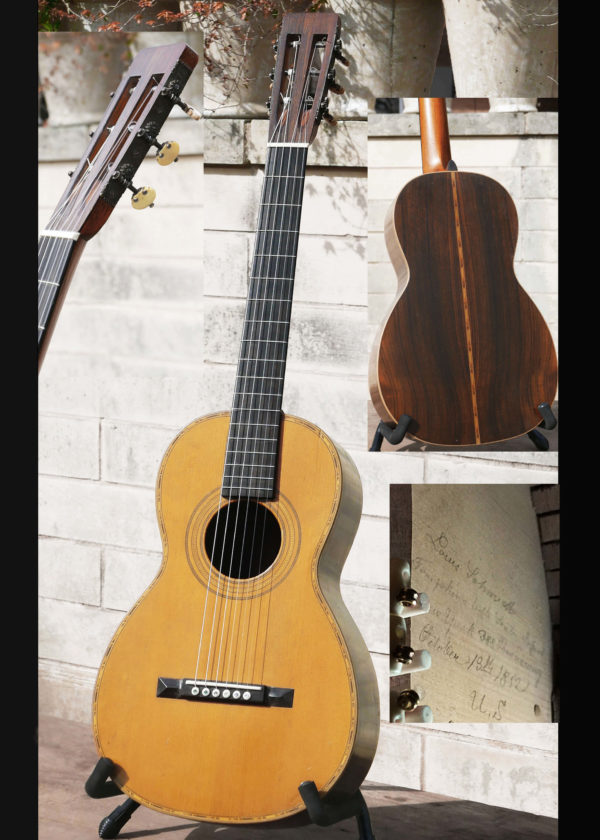 It’s beyond rare to find a guitar from the early Martin – Coupa - Schmidt – Maul – Schatz era in this state of preservation. And one this large. This rare model Schmidt & Maul guitar – by the original C.F. Martin's most famous colleagues and contemporaries– is signed and dated, October 18th, 1852, and is in its original coffin case. And best of all– it plays wonderfully, with low action. A unique piece of American guitar history– not for hanging on the wall but to play. The instrument is signed on the underside of the top: Louis Schmidt Tompkinsville Staten Island New York 388 Broadway October 18th 1852 U.S. This higher end, Spanish neck/heel (not ice-cream cone) Schmidt & Maul is bigger than all the Schmidt & Maul, Schmidt, or George Maul guitars that have come up for sale in the past decades (and not many of any kind have come up for sale). It’s a bit larger than a size 2 Martin, with a width at lower bout of 12 3/16 inches.(Every other Schmidt & Maul that has come to market has been a smaller guitar.) The guitar is braced inside (all original) with an early X-bracing variation similar to the 1953 Schmidt & Maul featured on p. 213 of the book “Inventing the American Guitar– The Pre-Civil War Innovations of C.F. Martin and His Contemporaries” edited by Robert Shaw and Peter Szego. (Hal Leonard Books, 2013). Like the 1853 guitar illustrated in that book, this guitar has bracing on top and back that is very close to the guitar that CF Martin and Schatz made for Madame de Goni. With all original finish, original ebony bridge, and original Jerome tuners– it’s in remarkable condition. To get the best of both worlds– historically authenticity and playability– the guitar has just had a recent neck set, original bridge reglue, and other minor work including new saddle, by one of the country’s top luthiers and authorities for early Martin and early American guitars– Steve Kovacik. All work was done by Steve to historically correct preservation standards after extensive examination and consultation. (Note, in the photo: the picture of the signature inside the guitar: the two cleats are not later repairs– rather they are two center seam-stabilizing cleats put in by the original luthiers in 1852.) Amazingly, this guitar plays in tune up and down the fretboard. Thank the original luthiers at 388 Broadway for that– they had the foresight to add slight compensation (not angled saddle compensation but cheating the saddle back a bit) to the bridge/saddle. Not even CF Martin did that in those years). And thanks to Steve Kovacik for setting this instrument up with low action not ballpark “19th century” action. The Adirondack top is crack-free. Crack-free sides. There are two almost imperceptible cracks on the back– you have to look hard to see them, both addressed by Steve Kovacik.
It’s beyond rare to find a guitar from the early Martin – Coupa - Schmidt – Maul – Schatz era in this state of preservation. And one this large. This rare model Schmidt & Maul guitar – by the original C.F. Martin's most famous colleagues and contemporaries– is signed and dated, October 18th, 1852, and is in its original coffin case. And best of all– it plays wonderfully, with low action. A unique piece of American guitar history– not for hanging on the wall but to play. The instrument is signed on the underside of the top: Louis Schmidt Tompkinsville Staten Island New York 388 Broadway October 18th 1852 U.S. This higher end, Spanish neck/heel (not ice-cream cone) Schmidt & Maul is bigger than all the Schmidt & Maul, Schmidt, or George Maul guitars that have come up for sale in the past decades (and not many of any kind have come up for sale). It’s a bit larger than a size 2 Martin, with a width at lower bout of 12 3/16 inches.(Every other Schmidt & Maul that has come to market has been a smaller guitar.) The guitar is braced inside (all original) with an early X-bracing variation similar to the 1953 Schmidt & Maul featured on p. 213 of the book “Inventing the American Guitar– The Pre-Civil War Innovations of C.F. Martin and His Contemporaries” edited by Robert Shaw and Peter Szego. (Hal Leonard Books, 2013). Like the 1853 guitar illustrated in that book, this guitar has bracing on top and back that is very close to the guitar that CF Martin and Schatz made for Madame de Goni. With all original finish, original ebony bridge, and original Jerome tuners– it’s in remarkable condition. To get the best of both worlds– historically authenticity and playability– the guitar has just had a recent neck set, original bridge reglue, and other minor work including new saddle, by one of the country’s top luthiers and authorities for early Martin and early American guitars– Steve Kovacik. All work was done by Steve to historically correct preservation standards after extensive examination and consultation. (Note, in the photo: the picture of the signature inside the guitar: the two cleats are not later repairs– rather they are two center seam-stabilizing cleats put in by the original luthiers in 1852.) Amazingly, this guitar plays in tune up and down the fretboard. Thank the original luthiers at 388 Broadway for that– they had the foresight to add slight compensation (not angled saddle compensation but cheating the saddle back a bit) to the bridge/saddle. Not even CF Martin did that in those years). And thanks to Steve Kovacik for setting this instrument up with low action not ballpark “19th century” action. The Adirondack top is crack-free. Crack-free sides. There are two almost imperceptible cracks on the back– you have to look hard to see them, both addressed by Steve Kovacik.- “Schmidt & Maul New York” stamps on neck block, and center strip inside guitar
- X-braced, all original braces inside
- Spanish foot construction
- Radiused Ebony fretboard
- All historically correct bar fret replacement by Steve Kovacik (not too high, and not too thick– correct size bar frets were used, properly finished)
- Original bridge plate, in fine condition
- Original Jerome tuners and buttons
- Original nut, and saddle, in case. New nut and saddle by Steve Kovacik
- Rosette: shares a feature with early Martins– a variant of the "tooth" rosette– a three ring rosette with green "tooth" inner ring, and small "rope" outer rings
- Marquetry Purfling around top, + Maple binding
- Back purfling (backstrip): see Martin Guitars: A Technical Reference, p. 13: this is a “Pre-1867 style 34” Martin style purfling
- Maple binding, back
- Solid Adirondack top
- Solid brazilian rosewood back and sides
- Cedar, Spanish style neck and heel
- Width at lower bout: 12 3/16 inches
- Body length: 18 ¼ inches
- Nut width: 1 15/16 inches
- String spacing at bridge: 2 5/16
- Scale length: 24 ½ inches (But there is a slight compensation: 12th fret to the saddle– Schmidt and Maul added a touch of compensation !
- Original scooped-back ebony bridge
- 100% original finish. No overspray, touch-up, etc. anywhere…wonderful finish
-
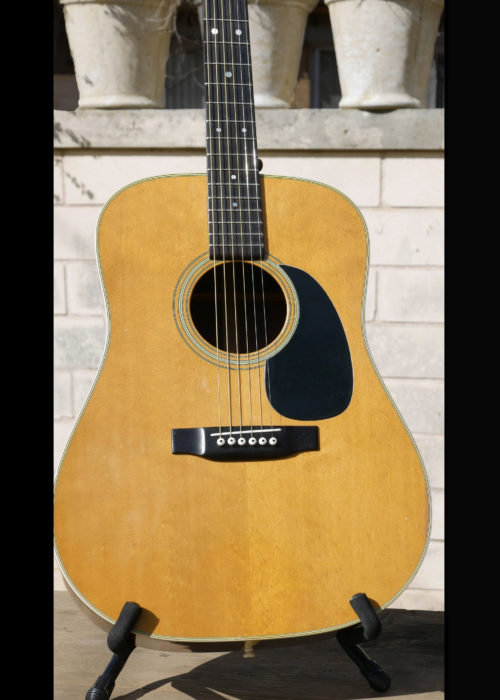 Many players consider the best Martin D-28’s from the 70’s great guitars– and the best value around if you want a vintage D-28 on a budget. The best ones deliver great tone– a darker, richer voice than 50's or 60’s D-28’s. The non-adjustable truss rod, and great Indian rosewood Martin used in those years, and the nice bear claw sitka on top on this example, all make for a lovely instrument. A few nicks and dings, but in remarkable original condition. This instrument delivers. It’s all original, and it’s 100% crack-free (not even the common “pickguard crack”). The original pickguard is not lifting as you often see on these Martins. Original bridge that's never been off the guitar, pins, everything. It has the typical slight finish crazing on top, visible from an angle– it’s common on this vintage. The neck has never been set. Frets in fine shape. Original Grovers. With a low-ish saddle, it plays fine. And in tune everywhere. At some point in the future the new owner may want to do a neck set, but we prefer to keep it all original (and the action is fine as is). ... no longer available – see the newly listed 1970 Martin D-28 in the Featured Instruments section.
Many players consider the best Martin D-28’s from the 70’s great guitars– and the best value around if you want a vintage D-28 on a budget. The best ones deliver great tone– a darker, richer voice than 50's or 60’s D-28’s. The non-adjustable truss rod, and great Indian rosewood Martin used in those years, and the nice bear claw sitka on top on this example, all make for a lovely instrument. A few nicks and dings, but in remarkable original condition. This instrument delivers. It’s all original, and it’s 100% crack-free (not even the common “pickguard crack”). The original pickguard is not lifting as you often see on these Martins. Original bridge that's never been off the guitar, pins, everything. It has the typical slight finish crazing on top, visible from an angle– it’s common on this vintage. The neck has never been set. Frets in fine shape. Original Grovers. With a low-ish saddle, it plays fine. And in tune everywhere. At some point in the future the new owner may want to do a neck set, but we prefer to keep it all original (and the action is fine as is). ... no longer available – see the newly listed 1970 Martin D-28 in the Featured Instruments section.